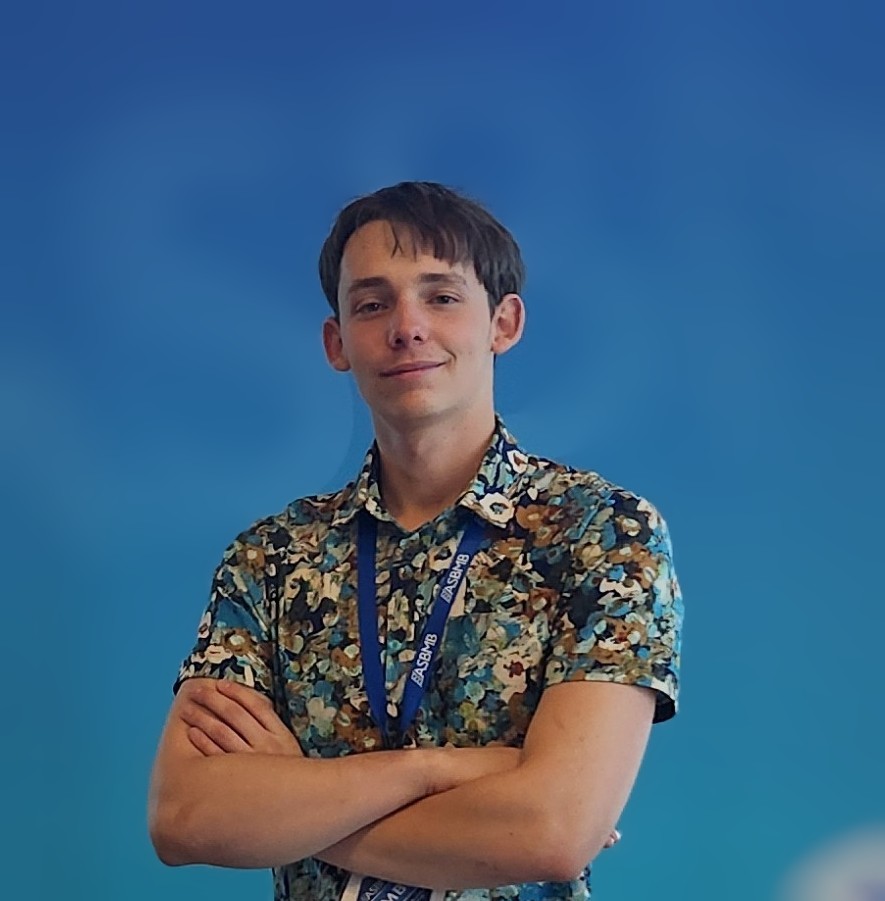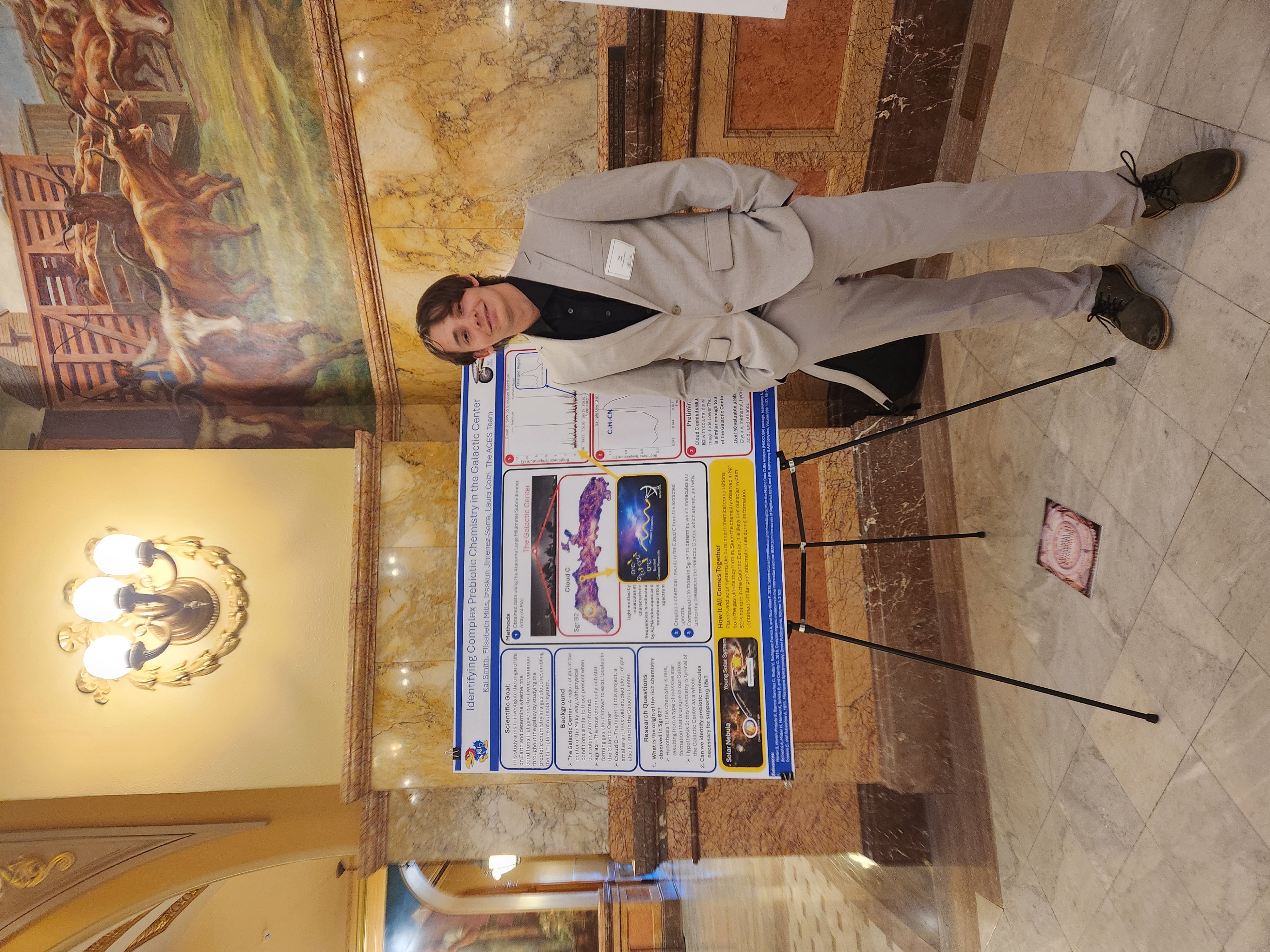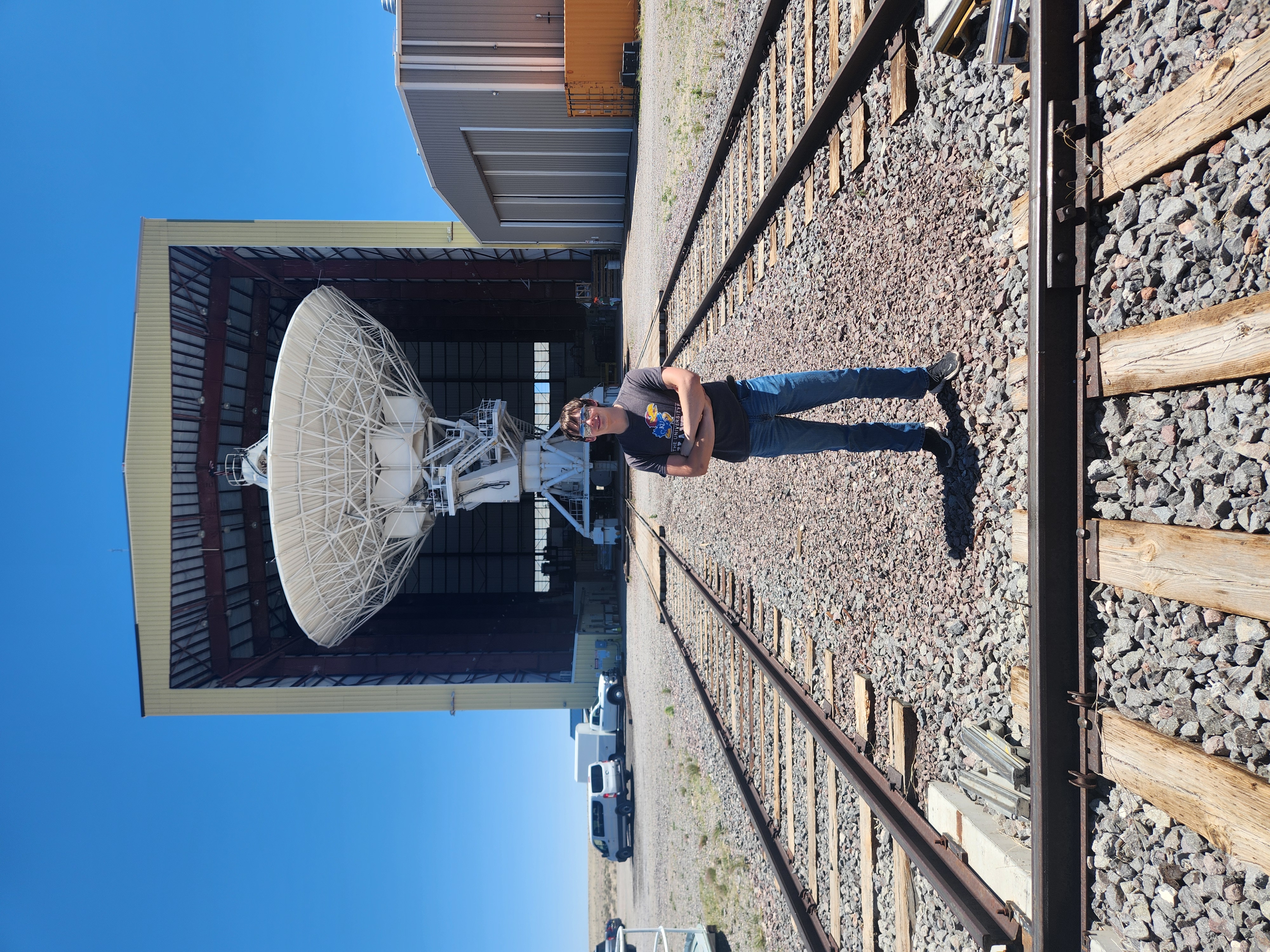Undergraduate Biology Student Researcher: Kai Smith

Kai is currently a junior majoring in biochemistry with a minor in astrobiology.
Kai: “I study how molecules form in space and track the reactions they make. To do this, you have to use a form of spectroscopy using large radar dishes. The reactions I'm looking at are in the center of our galaxy, about 30,000 light years away, in clouds of gas that can collapse into stars over time. When they collapse, the gas interacts as it starts to heat up and becomes denser and can form all sorts of really interesting molecules [like] glycine, adenine, guanine, and other organics. These structures can then form more complex organics such as sugars, fatty acids, or RNA bases like uracil when they get trapped within asteroids.
I look at the center of our galaxy to compare two different gas clouds, one of which exhibits massive star formation, which we think might be causing it to basically form all this unique chemistry, and then I compare it to a region that has normal star formation. I'm trying to see if they have similar chemistry essentially, to determine what the origin of that chemistry might be. if it's due to that massive star formation or more complex reaction dynamics that don’t follow standard reaction mechanisms observed in other regions of space.”
Q: That sounds like a lot of math, how are you figuring out what these molecules are?
Kai: “The short answer is yes, but I don't do it. […] I can observe these molecules in all these different states, and that can tell me how much of [the molecule] is present, what temperature it exists at, and what state it might be in. Then I use that information to find out what molecules are present. Which, we already know based off of databases […] through NASA where they've done research on millions of reactiKai Smith giving research presentation at KS State Capital building in Tokepa. He stands beside a large poster displaying his research. Kai is wearons. “

Q: How did you first become interested in this research?
Kai: “I was originally pre-med and not interested in research, […] then I joined the Honors microbiology lecture taught by Dr. Mark Mort, and we had a section on the Miller–Urey experiment, and I thought it was really interesting. I ended up sitting in the hall reading more about it, and I was there for two hours, and I missed my next class.
[…] I ended up joining a NASA internship, where I designed a spectrophotometer to trace prebiotic organics. Then I found out KU has a similar lab here, so I emailed Doctor Mills, who's runs that group and asked if I could join. She thought I was interesting because she's an astronomer and I'm a biochemist, and she doesn't see students outside of astronomy interested in her work. In that sense I was very helpful because I had a decent foundation in chemistry from my major and previous work with NASA. That's how I got involved.”
MILLER–UREY EXPERIMENT : in 1952 a chemical synthesis experiment simulated the conditions thought at the time to be present in the atmosphere of the early, prebiotic Earth. It is seen as one of the first successful experiments demonstrating the synthesis of organic compounds from inorganic constituents in an origin of life scenario.
Q: What does your research look like on a day-to-day basis?
Kai: “That depends on the stage I’m in, right now the main thing I'm doing is line identification. What that means is I have a lot of data packages and a lab computer where I have about three terabytes worth of data cubes to analyze. The data cubes are these three-dimensional regions of space, kind of like a 3D graph. I'm extracting spectra from those regions and then analyzing them using software analysis to look at the lines. After doing that I discuss my work with other ACS members. I'm working with a group in Madrid, Spain, and they're going back and forth with me on some of the stuff I found compared to the regions they're looking at.
Earlier, though, it was learning how to use programing pipelines my work is largely computational so I had to learn how to code. I got to travel to New Mexico where the very large array was, and they had me do training on the interferometric telescope up there, which was really cool.
I also learned how to work with the Alma pipeline, which is the telescope I'm working with right now. It's one of the most advanced on Earth. I was in person, getting training from the people who run the telescope, getting to see how it works, which is really fun.”
Q: Have you made any discoveries or findings? or What’s something interesting you’ve learned from being a part of your lab?
Kai: “I've made quite a few. I'm about three quarters of the way through the data I'm looking at, and I've found that Cloud C, which was theorized to be less organically rich than Sagittarius B (Sgr B2) --that's the big cloud with the massive star formation that is known to be extremely chemically rich-- I found that cloud C actually exhibits chemistry very similar to Sgr B2. I found interesting structures like guanine, cytosine, alanine in Cloud C.
I have observed that the two clouds exhibit similar molecular species being 88% similar, however Sgr B2 is significantly denser averaging 100 times the number of molecules present in its cloud. In addition, some of the most complex species observed in Sgr B2 such as acetonitrile, and ethyl format are present in cloud C as well suggesting further similarities in their chemistry.
What's really cool about that is if this chemistry is actually similar [when comparing Cloud C and Sagittarius B], it could suggest that these organic molecules we're finding could be visible elsewhere in the galaxy around regions that form like our solar system.
Because Sgr B2is the densest, most active cloud in our entire galaxy, it's very unlikely to see this sort of thing like elsewhere. But Cloud C is not-- Cloud C resembles chemistry and clouds more similar to what our solar system forms and the fact that I'm seeing the kinds of molecules I've been seeing in Sgr B2 means that when our solar system formed and when planets were forming, these kinds of essential prebiotics existed in space in the region around it, or at least it’s very likely they did.
Which is awesome, because that means the [molecules] could be trapped in things like comets or asteroids and then be deposited on planet, which helps answer one of the most troublesome questions [we face].
I need to completely finish all the data cubes and then I'm going to make some much more extensive analysis where I look at all the cubes at once and make sure that the column densities are correct, all the temperatures are correct, and then compare it to stuff other people in ACS have been seeing. So keep in mind these are preliminary results.”

Q: What did you find most challenging about getting involved in or doing your project?
Kai: “Honestly, finding time. I average 18 to 20 credit hours a semester as a BioChem major, which is not fun. This research is pretty extensive work, and I don't get paid for it, unless it's over summer, so I need to find time to do that, while also managing a job and finding time for scholarships. I'm also involved in four different clubs and I'm an executive member in three of them. So, the biggest challenge was definitely finding time to do this research.”
Q: What advice would you offer to other students facing similar challenges?
Kai: “First, make a schedule and try to stick to it. When I first tried research, I did not have a schedule and never did as much as I wanted to. Then I made a schedule that basically had me doing research for 30-minute intervals at 12 different points in one day, which never worked. So, I forced myself to block out large periods of time within the week, and it sucked because I definitely had to move things around or drop some other responsibilities. But it has given me enough time so when I try and work, it is productive and I’m not just sitting there trying to understand what’s going on for 30 minutes. It has made my life so much easier, so I cannot recommend enough do that.
Secondly, no matter what research lab you're in, if you are doing research and find you don't like it, just leave, it’s okay to leave. Professors will understand, and you will find more valuable uses for your time. I have changed between 3 labs already in my years at KU!
Q: Do you have anything else you would like to share about yourself?
Kai: “I’ve been working to build an outreach program that goes to underprivileged schools. I come from a small school in the middle of nowhere. We didn't even have a science teacher in my senior year, we were struggling that much financially, so I never got to see outreach. No STEM, nothing like that. A lot of my friends felt like they were completely unwilling or unable to go to university because it was such an intimidating idea. I felt the same way. I honestly was terrified of the idea of going to university.
[So I decided ] to build a program that travels out and goes to communities that need it. I just got back from working with McLouth and they'd never had outreach before either, the science teacher was so happy [to have us]. We made a huge difference. We worked with 90 kids. It was amazing.”
Q: What do you plan to do after you graduate from KU?
Kai: “I'm planning on going to graduate school and joining a lab looking at atmospheric chemistry or some form of planetary science. Though, with the nature of hiring freezes and everything that has been going on right now, I think I'm actually going to spend a year and a half at Peace Corps because the volunteer work there is really interesting. I would love the chance to go out and work with a different culture and learn practices outside the United States.”